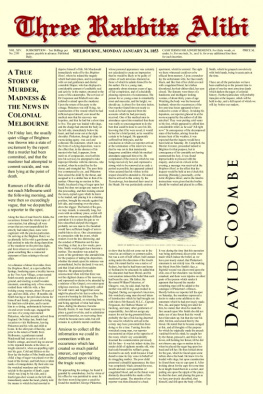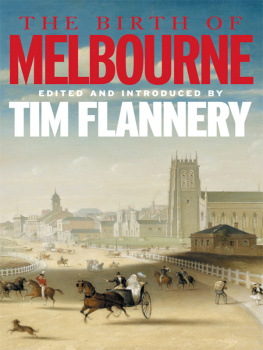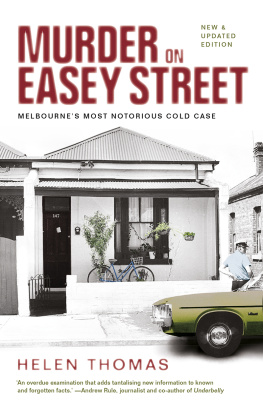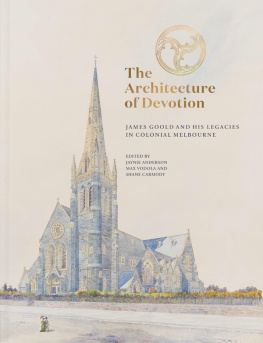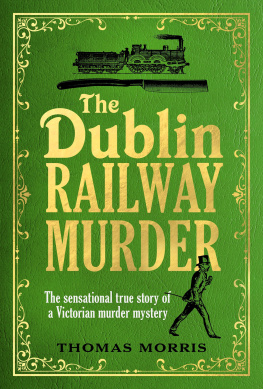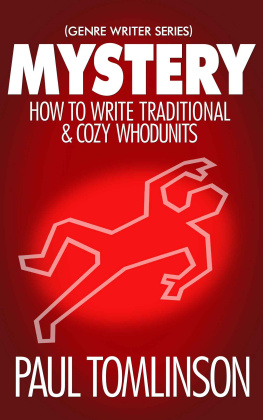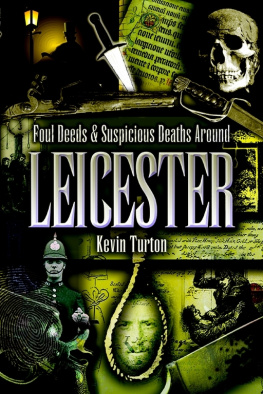THREE RABBITSALIBI
By David Coombe
A True Story of Murder,Madness and the News in Colonial Melbourne
Copyright 2014-16 DavidCoombe
Edition 1.4, 5 July2016
First Published: 20March 2013
Published by DavidCoombe at Smashwords
All rights reserved.Without limiting the rights under copyright above, no part of thispublication shall be reproduced, stored in or introduced into aretrieval system, or transmitted in any form or by any means(electronic, mechanical, photocopying, recording or otherwise),without the prior permission of both the copyright owner and thepublisher of this book.
ISBN 978 1 31198 7341
Cover design incorporates the image:Wood engraving, Group of Rabbits First Prize, Exhibited by Mr.W. Bissell; Second Prize, Exhibited by Mr. H. Smith. Walter Hartengraver, Alfred Clint 1843-1924, artist. Published in The Australian News for HomeReaders , 25 August 1865. Source: StateLibrary of Victoria. Accession no(s) IAN25/08/65/5
* * * *
Contents
* * * *
Early on Saturday22nd January 1853, news reached Melbourne that a woman and a childhad been murdered in their farm house about 12 miles south of thecity. The sketchy report added that the murderer was neardeath.
The rumours werevague, so reporters from the citys two newspapers theMelbourne Morning Herald and the Argus made theirway to the scene. The Heralds reporter was the brilliantEdmund Neddy Finn. He was later better known by his pen nameGarryowen, author of The Chronicles of Early Melbourne, 1835to 1852.
The story theyheard that Saturday morning was that the pair were murdered theprevious day by the farm labourer, who then shot himself in thechest with a shotgun. All this had happened while Charles Smith,the husband and father, was said to have been twelve miles away ona day trip to the city.
Finns report ofthe murder indicated there was something awry. The implication wasthat the events may not have unfolded in the manner first thought.Finn did not repeat his puzzlement in his next report of theensuing coroners inquest, but there was still a hint that thehusband Charles Smith had something to hide.
Was there more tothis case than had at first appeared? What about Charles Smith?What about the farm labourer said to be the murderer? And whatabout the victims?
Modern access toarchives allows us to explore these questions; it allows us to lookinto the detail of this case in a way that 1853 did not. It allowsus to know more about the people involved than was known then. There-investigation reveals a more complex story; and a mystery.
*
The discovery andsubsequent actions of that afternoon and evening are here describedfrom the testimonies of Charles Smith and other witnesses fromthe newspaper reports, the Coroners inquest and the Supreme Courttrial. Charles Smith was the only one to testify as to whathappened before four oclock in the afternoon on Friday 21January 1853. From that time, other witnesses are on the scene.Some testimony has been transformed into dialogue where this can bereliably derived from testimonies.
This book is intwo parts. Part 1 recounts events of 1852-53 as they were generallyknown. Part 2 is the investigation unravelling a much fullerstory.
Archive material,such as testimonies, are sometimes included in the body of thisbook or, where more suitable, in appendices.
When a quotationis not specifically referenced, it is sourced from the MelbourneMorning Herald newspaper. When simply Garryowen orChronicles is cited, this refers to The Chronicles ofEarly Melbourne, by Garryowen (Edmund Finn).
Spelling in thenewspapers was not consistent then and is not consistent withcurrent usage. I have not imposed any consistency. To avoidjarring, the spelling in quotations tends to be reflected insurrounding text. I recommend you turn off your spelling radar.
This is a truestory.
*
Notes
[21] Notes areat end of book. Where supported by the ebook reader and format,clicking the reference will take you to the note; clicking the endnote will return you to the original reference in the body of thetext.
Quotations fromnewspapers retain the original spelling and punctuation which oftendiffer from modern accepted usage. [Sic.] is not used.
5 miles = 8kilometres (approximately)
1 (one pound) =20 s. (20 shillings)
1s. (one shilling) = 12 d. (twelve pence)
One crown = five shillings
One guinea = 1 1s.
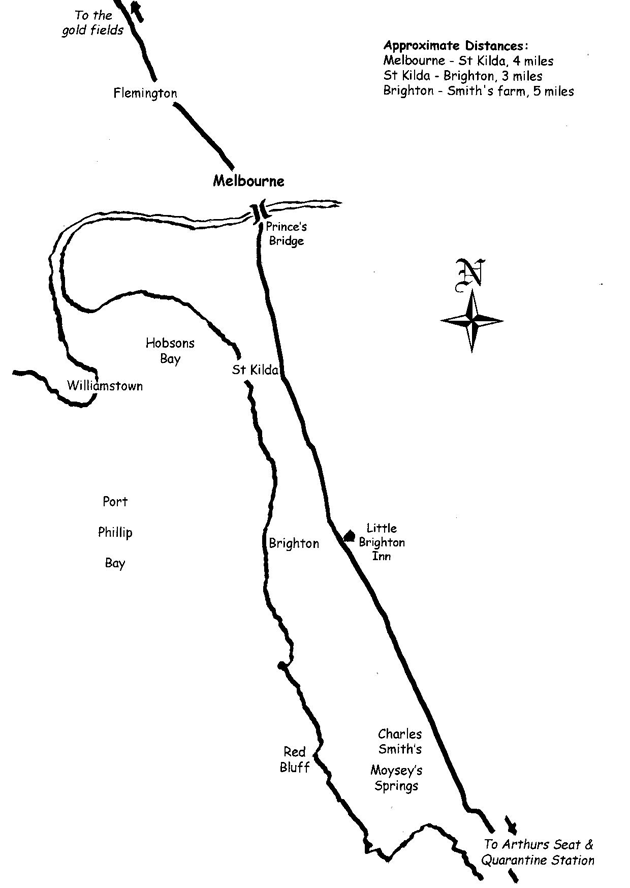
IMAGE Map, bythe author.
1852-3 was the maddestof the mad years in Melbourne, and it was no easy task to work anewspaper through the shoals and quicksands of the times.
Chronicles,
Edmund Finn
We begin with somenews reports from a few months before the murders.
*
Herald,Tuesday 19 October 1852 :
DARING ACTS OFBUSHRANGING.
On Saturdayafternoon four mounted bushrangers, armed to the teeth, swept thecountry between St. Kilda and Brighton, bailing up and robbingseveral persons. The first they met were Mr. and Mrs. Bawtree, nearthe Western Port Road, and from them they abstracted a gun, guncase, shot pouch, and some trinkets. They next came across agardener named Cain, who was fleeced to the tune of 20, andanother gardener fell a victim to the scoundrels rapacity in thesame amount within a couple of hundred yards of the scene of theother robberies. They next met with a Mr. ONeil, who likewiseunderwent the fleecing operation. In all they plundered about adozen persons, and as fast as they disposed of one they tied him upto their other victims, in order thereby effectually to guardagainst alarm or interruption; hiding them in a thicket, where theywere ordered to sit down in a ring facing one another, whilst onefellow stood guard, the rest plundering away until they had securednineteen persons in all! They also boasted of having killed a manand thrown his body into a waterhole. They appeared to have comefrom the direction of Melbourne passed on towards Keys Hotel, atLittle Brighton, and were last seen dashing at full speed after acarriage, but whether they succeeded in robbing it or not, we havenot heard; Mr. McCombie had a very narrow escape from them. Hehappened to be passing within a short distance and witnessing someof their movements, deemed discretion the better part of valour,and lost no time in securing a safe and speedy retreat. Thesedaring outrages clearly prove that some sort of efficientprotection should be afforded between Brighton and St. Kilda.
*
Argus,Friday 5 November 1852 :
TERRIBLE STATEOF AFFAIRS ON BOARD AN EMIGRANT SHIP AT THE PORT PHILLIP HEADS.
Intelligencewas brought to Williamstown on Wednesday evening last, by CaptWylie of the brig Champion, from Adelaide, that a largeship, named the Ticonderago, ninety days out from Liverpool,with upwards of 900 Government emigrants on board, had anchored atthe Heads. A great amount of sickness had occurred among thepassengers, more than a hundred deaths having taken place, andalmost a similar number of cases (typhus fever) being still onboard. Nor was this all. The doctor's health was so precarious thathe was not expected to survive, and the whole of the medicines,medical comforts &c, had been consumed.
*
Herald,Saturday 15 January 1853 :
DEATH FROMINTEMPERANCE.
For the pastweek, a small farmer at Little Brighton named William Smith,indulged rather too freely in intoxicating liquors, and theconsequence was some frequent and severe fits of

